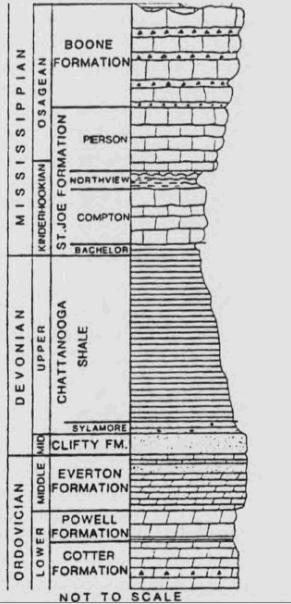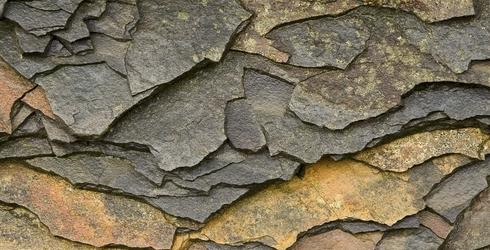As with all Earthcaches, there is no physical container to find here. TO LOG THIS EARTHCACHE, YOU MUST EMAIL ANSWERS TO THE 3 QUESTIONS FOUND AT THE BOTTOM OF THIS PAGE. Found logs without emailed answers will be deleted!
Did you know that all of Arkansas was once covered by ocean? In northern Arkansas, the waters were relatively shallow, and marine life was abundant. Much of this marine life had shells that were composed of calcium compounds which, over millions of years, accumulated on the ocean floor and hardened into limestone. Sand hardened into sandstone, and clay became shale. Most of these ancient layers are hidden beneath the surface but, in some areas, excavation, construction, and/or natural forces have exposed the rock, allowing us to glimpse millions of years back in time. (Source: EncyclopediaofArkansas.com)
As you walk along the Blowing Springs Nature Trail, you will observe some of these exposed rocks and note the distinct layers that were formed when Northwest Arkansas was still under water.
Stratigraphy is a branch of geology which studies rock layers and layering. Geologists use the information collected in stratigraphy to understand what was happening in a given geography at different points in time - including what plants and animals were present, where water flowed, what the climate was, and even the composition of the gasses in the air. Studies of the stratigraphy of Arkansas have resulted in diagrams, known as “Stratigraphic Columns” of the sedimentary layers present in different regions of the state. Below is an example of the stratigraphic column for the Rogers Quadrangle in Benton County: (Source: "Bedrock Geology of Rogers Quadrangle, Benton County, Arkansas," Jon C. Dowell, Camille M. Hutchinson, and Stephen K. Boss")
 </
</
There are two primary geological layers that are visible on the Blowing Springs Trail:
- The Boone Formation, which is a layer of cherty limestone that was formed during the Mississippian Period and dates back somewhere between 325 and 350 million years and,
- Chattanooga Shale, which is a layer of sedimentary rock that was formed during the Devonian period and dates back between 350 and 420 million years.
Boone Formation:
“Limestone is a sedimentary rock composed primarily of calcium carbonate in the form of the mineral calcite. It most commonly forms in clear, warm, shallow marine waters. It is usually an organic sedimentary rock that forms from the accumulation of shell, coral, algal and fecal debris”. (Source: geology.com)
The Boone formation came into existence during the Mississippian period (323-358 million years ago), when the oceans covering Arkansas were becoming shallower and warmer and beginning to recede. As the most “recent” layer of sedimentary rock formed in this area, the Boone Formation often appears at the tops of hills where rock has become exposed in Northwest Arkansas. It is composed mainly of finely crystalline limestone with some chert and minor/thin layers of shale.
Limestone is highly soluble in water and acid, and is therefore susceptible to erosion from rain and other weather. As the limestone is dissolved away, less soluble rock and minerals are left behind, creating arches, tunnels, and (in underground limestone beds) caves. As you walk the Blowing Springs Trail, note how erosion has shaped the limestone bluffs around you.
Chattanooga Shale:
 </
</
“Shale is a fine-grained sedimentary rock that forms from the compaction of silt and clay-size mineral particles that we commonly call “mud.” this composition places shale in a category of sedimentary rocks known as “mudstones”. Shale is distinguished from other mudstones because it is fissile and laminated. “Laminated” means that the rock is made up of many thin layers. “Fissile” means that the rock readily splits into this pieces along the laminations”. Source: Geology.com
Shale is typically gray, but can appear in a variety of colors depending on the mineral and organic composition of the mud that it formed from. Red, brown, and green colors indicate the presence of ferric oxide (reds), iron hydroxide (browns and yellows), or micaceous minerals (greens). Black shales contain organic material that sometimes breaks down to form natural gas or oil. The natural gas in shale can sometimes be recovered by using high pressure water to fracture the shale and release the trapped gasses. This process is known as hydraulic fracturing, or “fracking”.
As you walk the Blowing Springs trail, you will come across numerous veins of exposed shale - note the variations in color and composition, and keep in mind that this sedimentary layer was formed under the ocean nearly 400 million years ago!
LOGGING REQUIREMENTS: Before logging this Earthcache, please email answers to the following questions, which can be answered using your observations on the trail and the information on this page:
- At the published coordinates, observe the texture of the the rock bluff. Does the rock appear to be one solid layer or multiple thin layers?
- Also at the published coordinates, which of the following geological features is present: a) cave, b) rock arch, c) spring?
- At Waypoint “Shale,” you will see a large exposed area of Chattanooga shale. Based on the color of the shale you observe here, would you say that it does or does not contain organic matter (rinse it in the water here for a clearer picture of the color)?